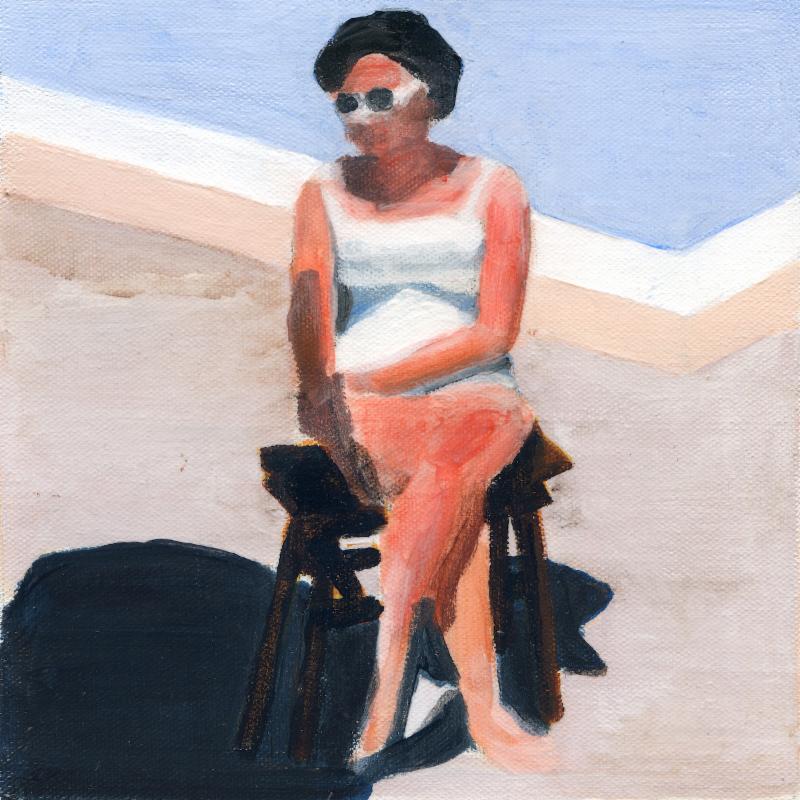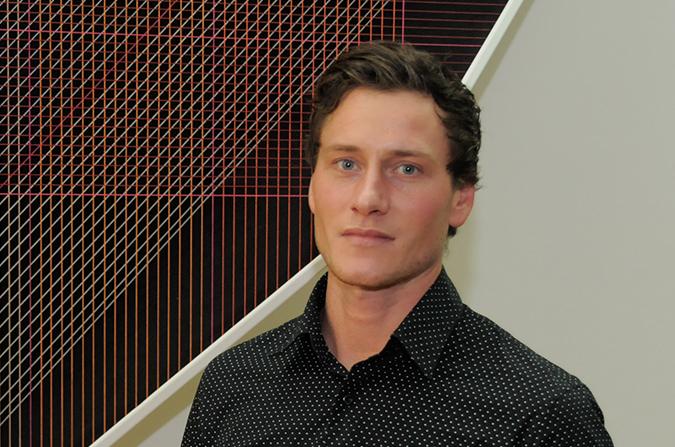New York Art Dealer, SARAH HASTED Interviews Brooklyn Artist, MARK MANN
Art Dealer SARAH HASTED
Interviews Artist MARK MANN
O Uncolored People
Owen James Gallery
May 17 - June 30, 2018
O Uncolored People, Geraldine, 2015. Acrylic on canvas, 7 x 7”
MARK MANN is the most descent person I have ever known.
We met at college in Santa Fe, New Mexico so many years ago, and he has been quietly and consistently working his way through this thing called “the art world” ever since. Some artists don’t demand the spot light, they diligently work in their studios, making exceptional works of art, often overshadowed by all the hype and noise.
Mark has never been the squeaky wheel, nor has he been invisible.
With dozens of exhibitions under his belt, including one at the Corcoran Museum in Washington D.C., and notable New York galleries, like Laurence Miller Gallery, his work has been recognized and collected by the Los AngelesCounty Museum of Art, the Sir Elton John Collection, Yale University, the Museum of Fine Arts in Houston and the Progressive Collection to name a few.
Our shared histories include a lifetime of understanding, being raised in the Southwest, our love of art, our complicated upbringings in broken families. Mark and I spent a lot of our lives together, and we always understood the various definitions of the word “family” – and all that entails.
I don’t know about you, but growing up in families with modest to low incomes, meant your family vacations consisted of everyone being loaded up into the station wagon, windows rolled up, car sick while your mother chain smoked, shouting instructions like “don’t’ make me stop this car” - as we head out on that long drive to Little Rock, Arkansas or Tulsa, Oklahoma. You stayed in a cheap motel (not hotel), but it didn’t matter as long as it had a pool. The highlight of the trip was usually something simple, like having your mother teach you how to swim, all the while, trying not to get her perfectly set and curled hair wet, or your step father pretending his feet were sharks, humming the theme to Jaws and saying they were coming to get you…as you squeal with glee.
Most of Mark’s art work over the years has referenced his role in the complex family structure, navigating relationships with siblings, relatives, aunts, uncles and parents.
“O Uncolored People is an ongoing series of paintings depicting burnt sunbathers as a means to express a side of the American character, weary from excess and leisure and instilled with a dark sense of humor. As a group, these people of Anglo descent are over-exposed and vulnerable to a changing world where American superiority is challenged. Each painting’s title is based on popular boys and girl’s names from 1930’s Social Security records, meant to reference an older generation – tough, stoic, but now questioning their status. My goal is to bring qualities of both the strange and sentimental in these pictures – in much the same way the most miserable of vacations can, over time, become the fondest of memories.”
-MARK MANN
Think about all of your family vacations, the painful sunburns and the sweet moments that you often remember…those trips down memory lane, aren’t about the sting of the sunburn and usually have nothing to do with some grand experience or fancy place, but rather a simple, thoughtful and loving gesture or time spent with someone you love.
SH: What is your favorite memory of a family vacation?
MM: Most of our family vacations were road trips throughout Oklahoma and Texas. Favorite may not be the best word to use, lets say memorable. One time in particular we had arrived to the beach motel and my sisters rushed to get all the sunbathing time the could on our first day. Their resulting sunburns and mild heat sickness made for a comically tragic dinner which they wanted to cancel altogether. Our dad was determined to go out and have a good time no matter what. I’m sure I got my hamburger, so all is in order from my point of view.
SH: Everyone in your paintings seems to have a sunburn, why?
MM: It’s a symbolic reference to cultural excess and privilege. I ultimately think it refers to a time before concerns like using sunscreen or limiting exposure to UV light. A type of self-inflicted wound; this preoccupation with the feeling better in the short term while simultaneously disregarding safety in the long run.
SH: What is the importance of the pool in your work, we see it referenced so often?
MM: Pools are inherently a part of the postcard and vacation scenes I use for subject matter, but I also have an affinity for them as spaces for family interaction. There are boundaries to a pool (shallow end and deep end) that relate to stages of life and personal growth.
SH: I love the titles of the new paintings; can you tell me about them?
MM: The titles are inspired by popular boys and girl’s names from Social Security records, meant to reference an older generation that precedes baby boomers. It seems to me to be the most evident point of cultural and political divide in America.
SH: Way back in 1993, one of the first works I ever saw of yours, were plaster cast water guns with Chinese fortunes on the back. The new casts are various cactus plants in coffee cans and other vessels. Do they relate?
MM: That series from 1993, just after graduation from art school was some of the earliest sculptures I did with mold making and cast plaster. The resulting objects were basically a mash-up of Eastern and Western philosophies or elements of violence and non-violence rolled into one. There was an absurdity that appealed to me. Regarding the cacti, they embody that same contrast of forms and material I am drawn to. Strength vs fragility, scarcity vs abundance.
Cuban Cactus, Bustelo 2016.
SH: How do you think growing up in the Southwest has influenced your work?
MM: Despite the conservative side to my upbringing, I had a great amount of personal freedom as a kid growing up in the 70’s and early 80’s. Out all day with less supervision and the free time to explore was invaluable.
SH: What do you think the biggest challenge an artist faces now?
MM: From a local perspective, affording to live and work in New York City while maintaining a serious studio practice is the biggest challenge. In the bigger picture, staying present and focused amid the distractions that come with technology, communications and social media.
SH: How has your work evolved from your earlier series, “Are we there yet” and “Wish you were here”?
MM: Both series involved a great deal of nostalgia and looking to the past. Now that I’ve worked through those ideas, I can direct the work on current themes, whether personal or political.
For more information please visit the gallery and artist websites:







